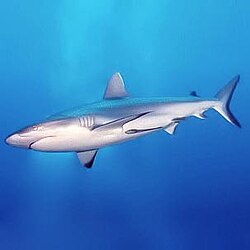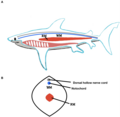Portal:Sharks
Welcome to the shark portal

Sharks are a group of elasmobranch cartilaginous fishes characterized by a ribless endoskeleton, dermal denticles, five to seven gill slits on each side, and pectoral fins that are not fused to the head. Modern sharks are classified within the division Selachii and are the sister group to the Batomorphi (rays and skates). Some sources extend the term "shark" as an informal category including extinct members of Chondrichthyes (cartilaginous fish) with a shark-like morphology, such as hybodonts. Shark-like chondrichthyans such as Cladoselache and Doliodus first appeared in the Devonian Period (419–359 million years), though some fossilized chondrichthyan-like scales are as old as the Late Ordovician (458–444 million years ago). The earliest confirmed modern sharks (Selachii) are known from the Early Jurassic around 200 million years ago, with the oldest known member being Agaleus, though records of true sharks may extend back as far as the Permian.
Sharks range in size from the small dwarf lanternshark (Etmopterus perryi), a deep sea species that is only 17 centimetres (6.7 in) in length, to the whale shark (Rhincodon typus), the largest fish in the world, which reaches approximately 12 metres (40 ft) in length. They are found in all seas and are common to depths up to 2,000 metres (6,600 ft). They generally do not live in freshwater, although there are a few known exceptions, such as the bull shark and the river sharks, which can be found in both seawater and freshwater, and the Ganges shark, which lives only in freshwater. Sharks have a covering of placoid scales (denticles) that protects the skin from damage and parasites in addition to improving their fluid dynamics. They have numerous sets of replaceable teeth.
Several shark species are apex predators, which are organisms that are at the top of their food chain with select examples including the bull shark, tiger shark, great white shark, mako sharks, thresher sharks and hammerhead sharks. Some sharks are filter-feeding planktivores, such as the whale shark and basking shark, which are among the largest fish ever lived. (Full article...)
Selected article -
Local and national reaction to the attacks involved a wave of panic that led to shark hunts aimed at eradicating the population of "man-eating" sharks and protecting the economies of New Jersey's seaside communities. Resort towns enclosed their public beaches with steel nets to protect swimmers. Scientific knowledge about sharks before 1916 was based on conjecture and speculation. The attacks forced ichthyologists to reassess common beliefs about the abilities of sharks and the nature of shark attacks.
The Jersey Shore attacks immediately entered into American popular culture, where sharks became caricatures in editorial cartoons representing danger. The attacks inspired Peter Benchley's novel Jaws (1974), an account of a great white shark that torments the fictional coastal community of Amity. Jaws was made into an influential film in 1975 by Steven Spielberg. The attacks became the subject of documentaries for the History Channel, Discovery Channel, and National Geographic Channel.
Did you know (auto-generated)

- ... that a shark cost a competitor a silver medal in the spearfishing event at the 2014 Micronesian Games?
- ... that the parasitic copepod Driocephalus cerebrinoxius burrows into the brains of sharks through their noses?
Categories
Related portals
WikiProjects
Selected picture -

More Did you know? -
- ... that the whitefin dogfish has light-producing organs on its upper eyelids?
- ... that the spinner shark is named for the spinning leaps it makes out of the water as part of its feeding strategy?
- ...that John Singleton Copley's painting, Watson and the Shark, was based on a real-life shark attack that occurred in Havana, Cuba in 1749?
- ... that, like the related cookiecutter shark, the kitefin shark sometimes feeds by taking bites out of animals larger than itself?
- ... that the first successful artificial insemination of a shark was performed in the cloudy catshark?
General images
Topics
For additional lists of marine life-related featured articles and good articles see:
Wikimedia
The following Wikimedia Foundation sister projects provide more on this subject:
-
Commons
Free media repository -
Wikibooks
Free textbooks and manuals -
Wikidata
Free knowledge base -
Wikinews
Free-content news -
Wikiquote
Collection of quotations -
Wikisource
Free-content library -
Wikispecies
Directory of species -
Wikiversity
Free learning tools -
Wiktionary
Dictionary and thesaurus






































